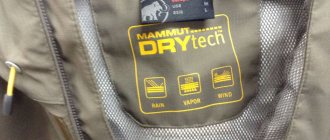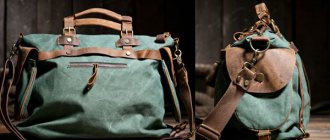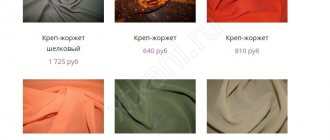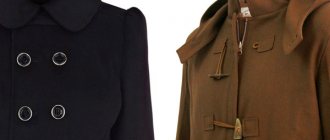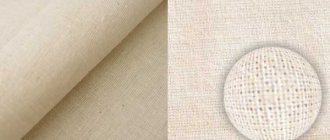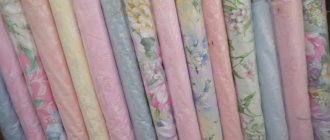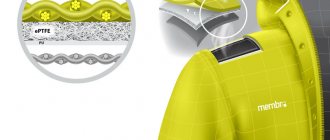What type of fabric is this
Triacetate fabric is a type of acetate silk. This is an artificial (not synthetic!) material obtained from solutions of triacetylcellulose in a mixture of methylene chloride and alcohol. The raw materials for its production are cotton or wood waste. Spinning of triacetate fiber is carried out using the dry method in machines that resemble in their design machines for spinning nylon fiber.
Triacetate colors
To obtain a thread, a solution of triacetylcellulose is pressed into a box - a device through which hot air is blown. During the blowing process, the solvents evaporate and the polymer fibers are sent to spinning machines. The result is a material with a smooth, shiny surface that is pleasant to the touch.
Catalog of fabrics made from artificial fibers
Appearance and characteristics
Triacetate is a relatively new material, having come into use a century ago when English chemists found a cheap way to process cellulose waste.
It is often called artificial silk because it is easily confused with natural material. Triacetate also shines beautifully, has a smooth and slippery surface, and is pleasant to the touch. But, thanks to its artificial origin, it surpasses natural silk in its ability to retain its shape after heat treatment. Therefore, it is indispensable in corrugated and pleated fabrics.
Fact. Cellulose triacetate fibers are actively used by manufacturers to produce many modern materials. Artificial threads are perfectly combined with cotton, wool, polyester, linen, rayon (rayon), etc., giving them strength, resilience, and elasticity.
Origin story
Acetates were first made from cellulose in Great Britain during the First World War by the Dreyfus brothers, which produced non-flammable varnishes for aircraft. Then this company improved the technique and began to produce acetate in the form of shiny threads, very reminiscent of natural silk.
Acetate
Artificial fabric acetate: what is this material and what are its features?
more details
Silk
Fame and luxury: a detailed review of silk fabric
more details
In the USSR, the first plant for the production of acetate thread was built in the Moscow region, in Serpukhov in 1954. The material was in great demand, as it had a number of characteristics characteristic of natural silk, but stood out for its affordable price. With the advent of new synthetic fibers, the demand for it has dropped markedly.
Acetate fabric – what is it, description
Unlike synthetics obtained from chemical compounds, acetate is a successful symbiosis of natural raw materials and reagents. To prevent the fabric from becoming electrified, the resulting thread is specially treated before weaving. Acetate lends itself well to coloring, which allows you to obtain a large number of bright shades.
In terms of its properties, acetate fiber is superior to ordinary viscose; it is more elastic, stronger, softer to the touch and less wrinkled, with a characteristic silky sheen. Acetate fabrics resemble natural silk in appearance and tactility, and the cost of production is much lower, as is the selling price.
Properties and characteristics
The properties of the British invention explain its popularity.
- Decorative - duplicating silk, allows you to sew beautiful things.
- Elastic - holds its shape well, which simplifies care and allows things to always look good.
- Pleasant – it does not create discomfort on the body; on the contrary, it is very pleasant to wear.
- Hypoallergenic - the viscose base is neutral, even allergy sufferers with sensitive skin can easily come into contact with acetate.
- Unpretentious - easy to wash, does not require special care, but you should handle it carefully, it is weak to tear when wet.
- Breathable - allows air to pass through well, but practically does not absorb moisture.
- Affordable - looks like silk, feels like silk, and costs significantly less.
Application
The characteristics of the fabric predetermined the scope of its application: consumer goods. All kinds of clothing and household items are sewn from it.
- Underwear, including everyone's favorite skimpy nightwear, negligees and dressing gowns.
- Outerwear.
- Bed sheets.
- Furniture covers.
- Curtains.
This is interesting: Calico or poplin - which is better for bed linen: comparison table, descriptions
Fabric composition and its properties
Since triacetate is a type of artificial silk, it has all the properties inherent in this material:
- elasticity;
- shine;
- softness;
- low creasing;
- ability to transmit ultraviolet rays;
- low hygroscopicity;
- resistance to alkalis and acids;
- easy to wash;
- ability to become electrified;
- reduced thermal stability: already at a temperature of 170°C the fibers begin to deform.
Types of fabric
Triacetate itself is a type of acetate silk, so it differs only in color: it can be plain-dyed or printed. At first, fabric production was complicated by the lack of suitable dyes. But then, with the advent of special dyes, the textile industry began to produce a great variety of colors of this material.
Triacetate is often used as an additive to other fabrics: wool, cotton, knitwear. This additive improves the properties of fabrics: it prevents the appearance of pilling on products and reduces the wrinkling of fabrics.
Caring for triacetate products
The products are easy to wash and are not subject to shrinkage or shedding.
In addition, dirt does not penetrate deep into the fiber and easily “falls behind” it when washed with ordinary detergents. It is not recommended to use substances containing large amounts of chlorine, as well as bleaches and other aggressive washing compounds - this can cause discoloration of the fabric. In addition, you can wash clothes made from triacetate using more gentle substances.
Triacetate drapes well, so it is often used when sewing complex outfits and creating durable pleating. The material is very durable and tolerates ironing well, if you follow the rules of caution and do not expose the fabric to high temperatures (you should iron it in the “Silk” mode). Clothes made from it dry very quickly after washing and practically do not wrinkle.[adrotate banner=»18"]
Advantages and disadvantages
Advantages of triacetate:
- silky, pleasant to the touch;
- retains its shape perfectly, especially when forming pleated folds;
- easy to care for: even difficult stains can be washed off easily;
- dries quickly, practically does not wrinkle;
- “uninteresting” for moths;
- looks like natural silk, but much cheaper.
There are also disadvantages:
- practically does not absorb moisture;
- low tensile strength of threads, especially when wet;
- not sufficiently resistant to abrasion, especially after frequent washing it loses its original appearance;
- afraid of high temperatures;
- Difficult to cut: slides and crumbles;
- electrified.
Rules of care
Step-by-step instruction:
- Wash products by hand or in a washing machine. The delicate mode or the “silk” program is recommended, but the standard mode is also chosen.
- The number of revolutions should be minimal, because when wet, the fabric tears easily. Water temperature – up to 70 degrees.
- Use regular powder. Do not use products containing chlorine or other aggressive substances.
- If there is a stain, do not rush with stain removers. In most cases it washes off easily.
- Triacetate dries quickly. Clothes are dried flat, because they also quickly become deformed. You can hang it on hangers.
- Ironing should only be done as a last resort. Iron the item on the minimum temperature from the wrong side. Set the “silk” or “wool” mode if they are present on the iron. At a temperature of 300 degrees, matter will melt.
- Store things on hangers so that there are no creases after lying folded.
We recommend
Tip: to prevent clothing from becoming electrified, it is recommended to spray it with an antistatic agent. It is especially worth paying attention to this in the summer.
Triacetate is a good material for making inexpensive casual and swimwear, and home textiles. Low cost and silk appearance make it more popular. After wearing something out, it’s not a shame to throw it away and buy a new one.
© 2021 textiletrend.ru
What standards are used in production?
All standards used in the manufacture of artificial fabrics, incl. and triacetate are prescribed in “GOST 23433-79 Fabrics and piece goods from chemical fibers”, namely:
- color fastness to light - OST 9733.1-91;
- color fastness to washing - according to GOST 9733.4-83;
- color fastness to ironing - according to GOST 9733.7-83;
- color fastness to friction - according to GOST 9733.27-83;
- air permeability - according to GOST 29298-2005;
- tensile tensile characteristics - according to GOST 3813-72.
For what purposes can it be used?
Beautiful appearance plus low price made this material in demand in light industry.
From triacetate they sew:
Inexpensive and beautiful underwear
Home clothes: dressing gowns, pajamas, negligees
Light outerwear: dresses, blouses, skirts (especially pleated ones)
Lining for coats, suits and raincoats
Bed sheets
Curtains and drapes, especially with complex drapery
What is sewn from acetate materials?
The budget cost and beautiful appearance allow the fabric to be used for sewing many consumer goods.
Triacetate dress
- Triacetate is used to make beautiful, inexpensive underwear, women's home clothing, and negligees.
- The qualities of acetate fabrics make it possible to sew outerwear from it.
- Elegant, affordable bedding can also be made from triacetate.
- Draperies and furniture covers can be sewn from thick acetate fabrics.
At what approximate price does it sell?
You can buy triacetate in stores selling fabrics at a price of 200 to 500 rubles per 1 meter (the width of the material is usually 135-140 cm). On online platforms specializing in the sale of vintage products, you can buy cuts of triacetate silk produced in the USSR. But it’s already more expensive - up to 700 rubles per linear meter.
Triacetate is a material that undoubtedly has certain advantages: it is pleasant to the touch, lightweight, drapes well, and most importantly, it is very similar to natural silk. But at the same time inexpensive. Therefore, despite the emergence of new artificial fabrics, it will be in demand among consumers for a long time.
Features and Benefits
Although this material has been used in light industry only recently, it has proven itself to be the best.
The positive characteristics of triacetate fabric include the following:
- Resistance to negative environmental factors, including ultraviolet radiation - clothing made of triacetate does not fade, maintaining its original appearance for a long period of time.
- Amazing shine - because of this shine, the material is often confused with silk.
- Pleasant to the touch - the perfectly smooth surface does not irritate the skin and evokes only positive emotions when touched.
- Very successfully used for draping and pleating.
- Durability - practically does not deform during operation.
- High wear resistance.
But it is necessary to take into account that triacetate fibers are inferior to natural ones in a number of properties, which include:
- Hygroscopicity – clothes made of triacetate practically do not absorb moisture.
- Breathability - the fabric does not allow air to pass through, and therefore the skin in such wardrobe items does not breathe.
- Thermoregulation - this material is not suitable for hot weather.
There are several ways in which it is quite easy to distinguish triacetate from natural silk . This can be done as follows:
- It is necessary to apply the product to the body - the artificial fabric will remain cold, and the silk will quickly acquire body temperature.
- If you deliberately crush the surface of the triacetate, or make a fold, it will not return to its original shape, and the natural material will smooth out almost immediately.
- When artificial fabric burns, there is practically no odor, and the burning of silk is usually accompanied by a specific aroma (reminiscent of burning hair).

